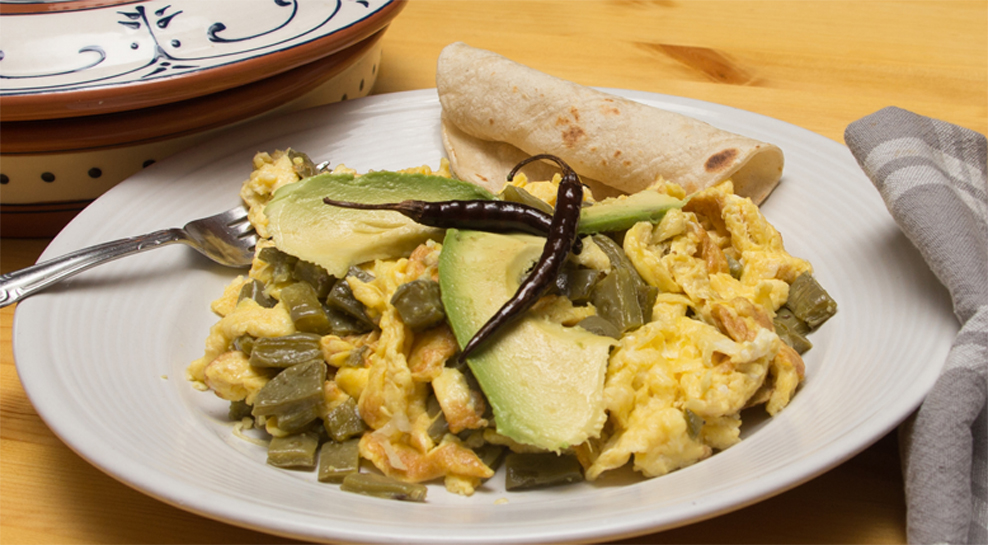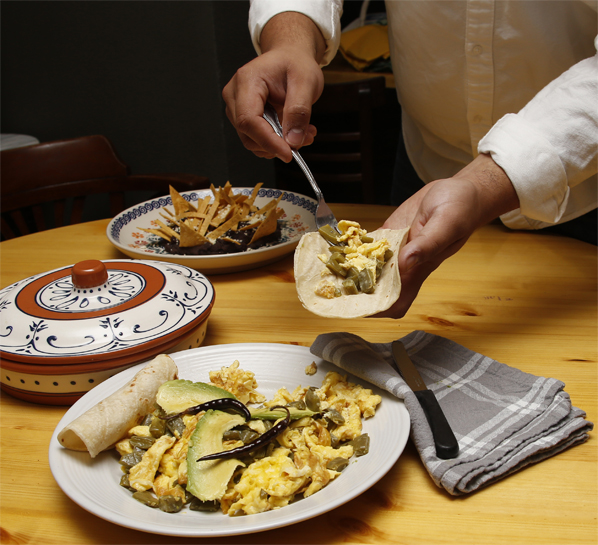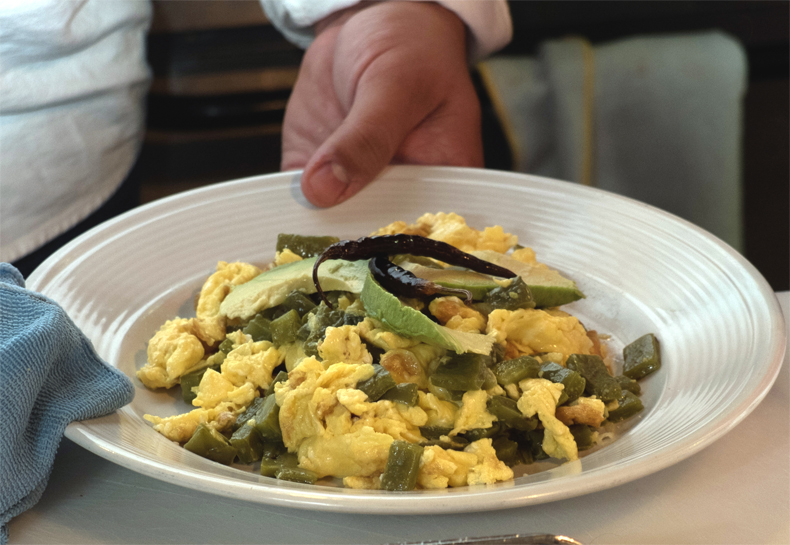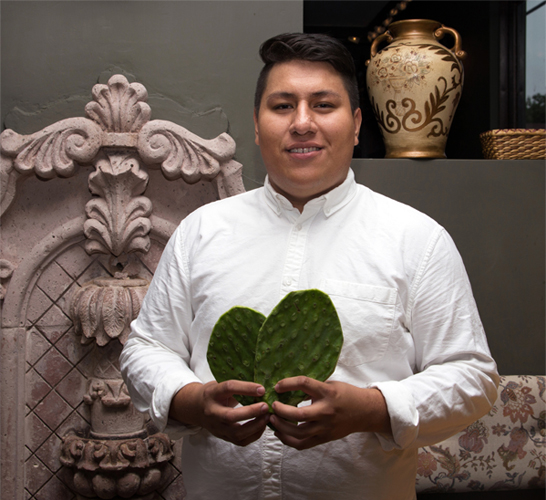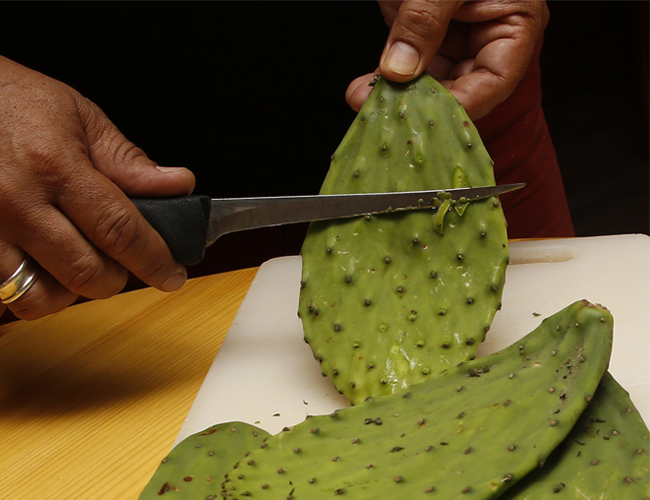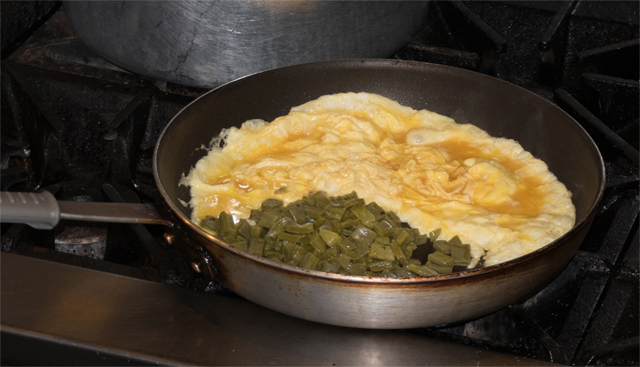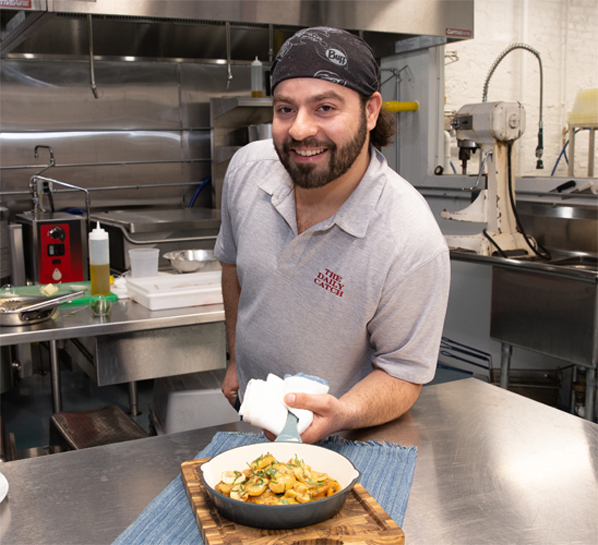Cactus and Eggs: the Bacon and Eggs of Mexico (and increasingly, the Northeast)
Cactus and eggs. It’s enough to make you go “ouch!” While it may sound painful to gringos, it's the bacon and eggs for many in Mexico, the Southwest, and right here in greater Boston. Cactus and eggs, or nopales con huevos, is often served with warm tortillas for making tacos at the table, and with sides like rice and black or pinto beans. It might be topped with avocado, cilantro, or pico de gallo. But it's the savory sweet pairing of fluffy scrambled eggs and fresh fried cactus that gives this dish its exceptional taste. At Chilangos in Providence it’s an off-the-menu special for those longing for the street and cantina food of Mexico, and for gringos-in-the-know.
"You grow up learning to cook it. It's so good. It's an almost magical combination," says Max Mendoza, 21, the youngest family member helping to run Chilangos.
Amanda Escamilla, 50, is passionate about the dish. It was the topic of one of the first instructional videos she created when she started TexMex Eats, a catering service in Cambridge.
Escamilla, who has a cactus-and-hummingbird tattoo on her upper arm, is remarkably knowledgeable about cooking with cactus in general. She rhapsodizes about her steak and cactus recipe, as well as the cactus and white bean soup her mother used to make.
It can “bring you back from the dead,” she says. Preparing and canning cactus was a family pastime for her, growing up in South Texas. For nopales con huevos, canned or pickled cactus, available in Spanish food aisles, is an option, but "go fresh whenever possible," she says.
Despite the growing availability of fresh nopales, Escamilla and the owners of Chilangos are more adventurous than most. Elsewhere, cactus dishes are rarely on the menu, even when the word "cactus" is in the restaurant's name. Although many cooks and chefs of Mexican and Guatemalan background prepare cactus dishes for themselves, until recently customers haven't shown great interest.
"It used to be 70-30 Mexican to Americans," says Mendoza, of the restaurant's clientele. “Now it's flipped the other way." Mendoza says it's because the menu goes beyond fast Mexican food. Chilangos, which has a casual neighborhood feel despite its experimental menu, draws customers from New York and the farther reaches of New England.
Still, the cactus world can be confusing to neophytes. Forget the notion of cactus as the forbidding, prickly-armed posts endemic to the landscape of arid desert land. Prickly pear cactus, or nopales, are grown commercially in the Southwest and Mexico. “Nopalitos” refers to the cut paddles, while prickly pear fruit, or “tuna,” is the purplish seed bulb, itself a sweet treat eaten raw that’s sold separately in markets.
Chilangos typically goes through a case of 25 pounds of nopales paddles a week. The entire amount is cleaned at one time. To remove the spikes, Mendoza's uncle, Juan Carlos Fierros (53) glides a sharp knife over the surface. He then traces around the edges of each paddle, discarding about an eighth of an inch of flesh. “Always pick the young thin short paddles about four or five inches in height; they’re the most tender,” he advises.
Mendoza is as adept in the kitchen as he is gentlemanly in explaining menu items and their tastes to restaurant guests. After a 20-minute hard boil of napolitos (cut into bite-size pieces, with onion and garlic as aromatics that he will discard), he tosses three chiles de arobles in a hot skillet to flavor the canola oil. After removing the chiles he pours scrambled eggs into the pan, leaving space for the nopalitos, which he then adds and stirs together in the fashion of making scrambled eggs. He garnishes the plated dish with avocado and the charred chiles “for those who are brave." The simplicity of Mendoza's version attests to how well the fairly unadorned ingredients work together.
Escamilla’s family tradition is to first sauté the napolitos with an array of ingredients like onion, cilantro, tomato and Mexican spices, and finish with a salsa verde or roja on top. "The inspiration for me in cooking with cactus is its history, its place in our food culture, and how it was prepared growing up," she says.
Chilangos has reworked a fresh cactus salad (previously served with pickled cactus from a bottle) to one that pairs with grapefruit in an agave-mustard vinaigrette. Cactus also comes into play in a smoky mole that includes a variety of dried chiles. A beet infused masa tortilla includes grilled cactus, crispy pork, avocado and queso fresco.
Some of the ideas come from a surprising place: Harvard. "I've attended their Science and Cooking Lecture Series since I was in high school," says Max. He usually drives up from Rhode Island with Juan Carlos, whose specialty is in the use of traditional ingredients.
"We're always learning," says Mendoza. Chilangos has even put grasshopper on the menu as a special. Alas, the family has to source it in New York.
Chilangos is a nickname for natives of Mexico City. The extended family that includes Mendoza’s mother, brother and two uncles are all Chilangos, which is especially appropriate. Tenochtitlan, the Aztec name for Mexico City, translates as the place of the prickly pear.
Many Stop & Shop, Market Basket, Shaw's and Latin American markets in the Boston area carry fresh nopales, both the paddles and often the prickly pear fruit.
Nopalitos con Huevos
(Cactus and Eggs)
Recipe by Max Mendoza | Chilangos restaurant
Ingredients:
4 young cactus paddles, about 5-inches tall
1/2 medium Spanish onion
4 cloves garlic
1 tablespoon canola oil
3 red chile de arboles
6 medium eggs
1 teaspoon salt
To clean and prepare cactus
1. Hold paddle on an angle and slide paring knife lightly over surface to remove spikes. Trim edges, discarding 1/8-inch of flesh. Trim about 1/2-inch from stem. Cut into ¾-inch pieces
2. In a large saucepan add cactus, onion, garlic and ½ teaspoon of salt. Cover with water by two inches and boil for 20 minutes
3. Using a strainer, drain and discard onion and garlic
To cook cactus with eggs
1. Heat canola oil in large skillet, over medium-high heat. Add chile de arboles, flipping back and forth until brown, approximately 3 minutes. Remove chiles from skillet and set aside
2. Whisk eggs with a dash of salt in medium bowl and set aside
3. Add eggs to about half the skillet, allowing space for the cactus. Add cactus and slowly fold into eggs. Stir gently for 3-4-minutes until eggs set. Plate and garnish with chile de arboles
4. Serve with warm corn tortillas
[Accompanies Cactus and Eggs story by Rachel Ellner, cell: 201-686-7869]
